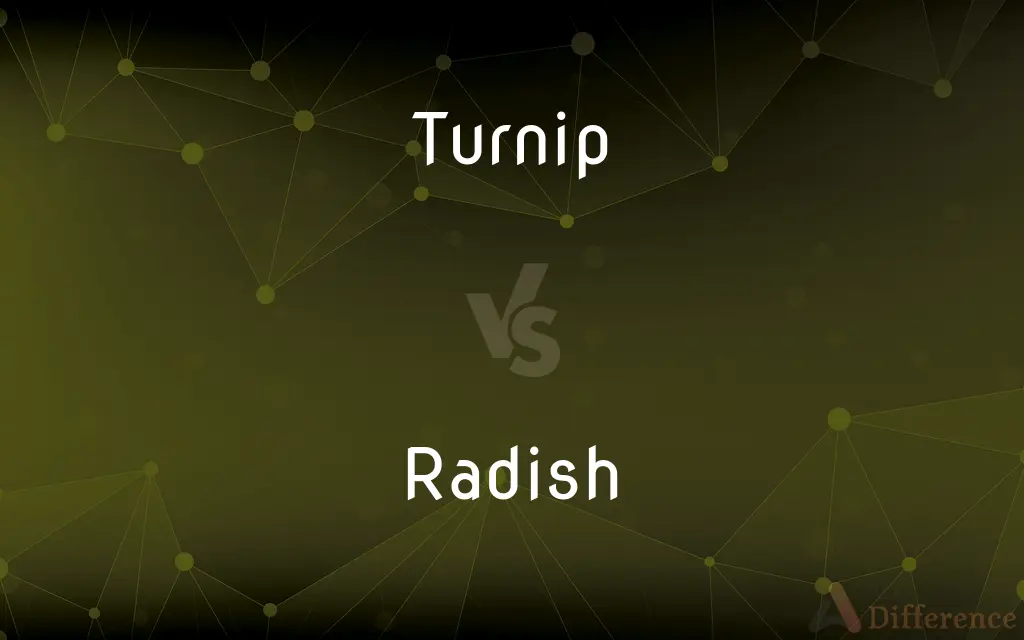Turnip vs. Radish — What's the Difference?
By Tayyaba Rehman — Updated on September 3, 2023
Turnip is a round, white root vegetable; Radish is a small, often red, pungent root vegetable.

Difference Between Turnip and Radish
Table of Contents
ADVERTISEMENT
Key Differences
Turnip is a root vegetable that primarily grows in temperate climates. It's known for its round shape and white or purple-tinted flesh. Its taste is mild, and it's often used in stews or eaten mashed. Radish, on the other hand, grows in many varieties and colors, from white to red to purple.
Radish is typically smaller than a turnip and can be spicy or sweet based on its variety. It's popular in salads due to its crunchy texture and sharp taste. Turnip, being larger and milder, is more versatile when it comes to cooking and can be roasted, boiled, or even eaten raw.
Turnip greens, the leafy part of the turnip plant, are edible and often enjoyed in various cuisines. They offer a slightly bitter taste. Radish leaves are also edible, but they're not as commonly consumed as turnip greens. Their flavor can be peppery, resembling the root they sprout from.
Both Turnip and Radish provide a range of health benefits. They're rich in vitamins, minerals, and antioxidants. However, while turnips are a good source of Vitamin C and manganese, radishes offer vitamin C, folate, and potassium.
The cultivation of Turnip dates back over 4,000 years, and they've been a staple in European diets for centuries. Radish has Asian origins and has been cultivated in Egypt since ancient times, spreading its popularity across the globe.
ADVERTISEMENT
Comparison Chart
Appearance
Round, white or purple-tinted flesh.
Small, varies in color (red, white, etc.).
Taste
Mild, slightly sweet.
Can be spicy or sweet.
Common Use
Stews, mashes, roasted.
Salads, pickles, raw eating.
Edible Greens?
Yes, slightly bitter.
Yes, peppery.
Nutritional Focus
Vitamin C, manganese.
Vitamin C, folate, potassium.
Compare with Definitions
Turnip
Turnip can be eaten raw, roasted, boiled, or mashed.
Roasted turnips can be a delicious side dish.
Radish
Radishes are a part of the Brassicaceae family, coming in various colors and shapes.
The red globe radish is commonly found in supermarkets.
Turnip
Turnip is a round root vegetable with white flesh and a pungent taste.
She added diced turnips to the stew.
Radish
Radish is a small, crunchy root vegetable that can range from sweet to spicy.
She sliced the radish for her salad.
Turnip
Turnip is often cultivated in temperate climates and is part of the Brassica genus.
Turnips thrive in cooler weather.
Radish
Radishes have been cultivated since ancient times, with origins in Southeast Asia.
Radishes are a staple in many traditional dishes.
Turnip
The green leaves of the turnip plant are edible and nutritious.
Turnip greens can be sautéed with garlic and olive oil.
Radish
Radish can be consumed raw, pickled, or as a garnish.
Pickled radishes are popular in some Asian cuisines.
Turnip
Turnip's cultivation dates back over 4,000 years in European history.
Ancient civilizations recognized the value of the turnip.
Radish
The greens of the radish plant are edible, with a peppery taste.
Radish greens can add a kick to your green smoothie.
Turnip
The turnip or white turnip (Brassica rapa subsp. rapa) is a root vegetable commonly grown in temperate climates worldwide for its white, fleshy taproot.
Radish
The radish (Raphanus raphanistrum subsp. sativus) is an edible root vegetable of the family Brassicaceae that was domesticated in Asia prior to Roman times.
Turnip
A round root with white or cream flesh which is eaten as a vegetable and also has edible leaves.
Radish
A swollen pungent-tasting edible root, especially a variety which is small, spherical, and red, and eaten raw with salad.
Turnip
The European plant of the cabbage family which produces the turnip.
Radish
The plant of the cabbage family which yields the radish.
Turnip
A large, thick, old-fashioned watch.
Radish
A Eurasian plant (Raphanus sativus) in the mustard family, having a fleshy edible root and white to purple flowers clustered in a terminal raceme.
Turnip
A widely cultivated Eurasian plant (Brassica rapa) of the mustard family, having a large rounded edible whitish root and edible leaves.
Radish
The pungent root of this plant, often eaten raw.
Turnip
The root of this plant, eaten as a vegetable.
Radish
A plant of the Brassicaceae family, Raphanus sativus or Raphanus raphanistrum subsp. sativus, having an edible root.
Turnip
Chiefly Northeast US A rutabaga.
Radish
The root of this plant used as food. Some varieties are pungent and usually eaten raw in salads, etc., while others have a milder taste and are cooked.
Turnip
The white root of a yellow-flowered plant, Brassica rapa, grown as a vegetable and as fodder for cattle.
Radish
With a distinguishing word: some other plant of the Raphanus genus or Brassicaceae family.
Turnip
The yellow root of a related plant, the swede or Brassica napus.
Radish
The pungent fleshy root of a well-known cruciferous plant (Raphanus sativus); also, the whole plant.
Turnip
(Hong Kong) The white root of Raphanus sativus var. longipinnatus, also known as a daikon.
Radish
Pungent fleshy edible root
Turnip
(dated) A large, heavy pocket watch, so called because its profile resembled the vegetable.
Radish
Pungent edible root of any of various cultivated radish plants
Turnip
(slang) A fool or simpleton.
Radish
Eurasian plant widely cultivated for its edible pungent root usually eaten raw
Turnip
(transitive) To plant with turnips.
Turnip
(transitive) To feed or graze (livestock) on turnips.
Turnip
The edible, fleshy, roundish, or somewhat conical, root of a cruciferous plant (Brassica campestris, var. Napus); also, the plant itself.
Turnip
Widely cultivated plant having a large fleshy edible white or yellow root
Turnip
Root of any of several members of the mustard family
Common Curiosities
Are Turnip greens edible?
Yes, turnip greens are edible and often enjoyed in various cuisines.
What is a Turnip?
A turnip is a round root vegetable with white or purple-tinted flesh.
What is a Radish?
A radish is a small root vegetable that can be red, white, or even purple and is known for its pungent taste.
Which is bigger, Turnip or Radish?
Turnips are generally larger than radishes.
Can you eat Radish greens?
Yes, radish greens are edible and have a peppery flavor.
Do both Turnips and Radishes belong to the same family?
Yes, both turnips and radishes belong to the Brassicaceae family.
Which is spicier, Turnip or Radish?
Radish tends to be spicier, while turnips have a milder taste.
How are Radishes commonly consumed?
Radishes are often eaten raw in salads, pickled, or used as a garnish.
Which has a stronger taste, Turnip or Radish?
Radish generally has a stronger, sometimes spicier, taste compared to the milder turnip.
How are Turnips commonly cooked?
Turnips can be roasted, boiled, mashed, or even eaten raw.
Where did Turnips originate?
Turnips have been cultivated for over 4,000 years, primarily in European regions.
Where did Radishes originate?
Radishes have origins in Southeast Asia but have been cultivated in places like Egypt since ancient times.
Are Radishes and Turnips good for health?
Yes, both are nutritious, rich in vitamins, minerals, and antioxidants.
Can Turnips and Radishes be grown in the same garden?
Yes, both can be grown in the same garden, especially in cooler seasons.
Which takes longer to mature, Turnip or Radish?
Turnips generally take longer to mature than radishes.
Share Your Discovery

Previous Comparison
Their vs. Its
Next Comparison
Tetraplegia vs. QuadriplegiaAuthor Spotlight
Written by
Tayyaba RehmanTayyaba Rehman is a distinguished writer, currently serving as a primary contributor to askdifference.com. As a researcher in semantics and etymology, Tayyaba's passion for the complexity of languages and their distinctions has found a perfect home on the platform. Tayyaba delves into the intricacies of language, distinguishing between commonly confused words and phrases, thereby providing clarity for readers worldwide.
















































